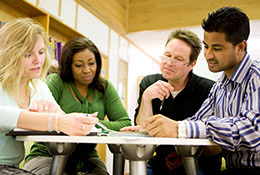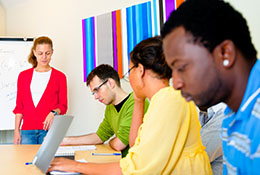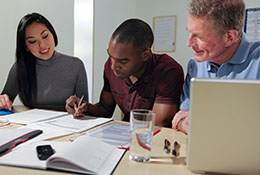SEDL INSIGHTS, Vol. 2, No. 3 (Winter 2014)
Implementing Effective Professional Learning Communities
SEDL Insights on Implementing Effective Professional Learning Communities
- Provide a clear structure and purpose for PLC meetings.
- Address the most pressing instructional challenges.
- Provide support from all levels of the school system.
- Foster an atmosphere of trust.
- Monitor the work of PLCs and provide constructive feedback.
- Support teachers’ sense of efficacy and level of professionalism.
Download PDF
District and school leaders seeking to improve student gains are often inundated with well-intentioned programs and supports that promise to produce rapid results.1 Determining the best structures, supports, and approaches to advance student learning outcomes while fostering an improved school culture and developing teachers’ instructional expertise can be a substantial undertaking.2 Various researchers have noted that the use of professional learning communities offers an effective, learning-focused process that can foster improvement in teaching and learning.3
At SEDL, we believe that the use of professional learning communities in schools offers a powerful infrastructure where teachers can engage in constructive dialogue, reflect on and improve instruction, and learn how to become more effective in the classroom to improve student learning. In addition, research indicates there is a strong correlation between the use of effective PLCs in schools and improved teacher learning and instruction and student learning.4 Through SEDL’s Center for High-Performing Schools, a program that partners with schools and districts to improve teaching and learning through professional development and technical assistance, we have helped education leaders in South Carolina, Louisiana, and Texas implement PLCs. We have drawn on this experience and recent research on school improvement to identify six insights that can help district and school leaders and teachers implement and sustain the professional learning community process.
 | Provide a clear structure and purpose for PLC meetings. |
 Through the provision of technical assistance to districts and schools, we have observed various types of teacher gatherings that are frequently referred to as PLCs. Such meetings are often a good first step; however, to bring effective PLCs to fruition, district and school leaders must focus on increasing teachers’ collaborative professional learning and self-reflection to improve classroom instruction for enhanced student gains — the hallmarks of an effective PLC to which teachers and leaders should aspire.
Through the provision of technical assistance to districts and schools, we have observed various types of teacher gatherings that are frequently referred to as PLCs. Such meetings are often a good first step; however, to bring effective PLCs to fruition, district and school leaders must focus on increasing teachers’ collaborative professional learning and self-reflection to improve classroom instruction for enhanced student gains — the hallmarks of an effective PLC to which teachers and leaders should aspire.
In our work with districts and schools, we have used a structured approach that defines what teachers do in a PLC.5 This approach includes
- studying standards, reviewing concepts and skills necessary to master the standards, and determining how the standards are assessed;
- selecting research-based instructional strategies and assessment techniques;
- planning lessons and agreeing on the evidence of student learning that PLC members will share;
- implementing lessons, noting successes and challenges, and collecting the agreed-upon evidence of student learning;
- analyzing student work by revisiting the standards being addressed and identifying student strengths and areas of need; and
- adjusting instruction after reflecting on disparate teaching experiences, selecting alternative instructional strategies, and determining how instructional challenges that may arise in the future will be addressed.
 To help district and school staff develop a clear picture of the collaborative work that teachers do in PLCs, when SEDL provides technical assistance through our train the trainer model, we demonstrate the work of PLCs in action and provide intentional, interactive learning tasks. These interactive sessions include modeling the collaborative routines, professional behaviors, and collegial practices that are crucial to holding productive PLC meetings. For example, we have conducted mock PLC meetings where district and school leaders play the roles of teachers. The participants use tools and protocols that support behaviors and practices learned throughout the sessions. This technique helps participants identify key behaviors, practices, and dialogue that foster or inhibit collaboration among PLC members. During these conversations, participants share revelations, questions, and observations about the PLC process.
To help district and school staff develop a clear picture of the collaborative work that teachers do in PLCs, when SEDL provides technical assistance through our train the trainer model, we demonstrate the work of PLCs in action and provide intentional, interactive learning tasks. These interactive sessions include modeling the collaborative routines, professional behaviors, and collegial practices that are crucial to holding productive PLC meetings. For example, we have conducted mock PLC meetings where district and school leaders play the roles of teachers. The participants use tools and protocols that support behaviors and practices learned throughout the sessions. This technique helps participants identify key behaviors, practices, and dialogue that foster or inhibit collaboration among PLC members. During these conversations, participants share revelations, questions, and observations about the PLC process.
Additionally, we provide demonstrations on how to hold collegial conversations with peers during PLC meetings. Participants are provided with a scenario, form triads, and take turns playing each of the three following roles: (1) a presenter who describes an aspect of instructional practice or student learning; (2) someone who asks the presenter questions, using questioning, paraphrasing, and probing skills that are crucial to conducting collegial conversations; and (3) an observer who provides feedback to the person asking questions. These tools and practices prepare teachers to become reflective practitioners and active participants in authentic PLCs.
 | Address the most pressing instructional challenges. |
 When districts and schools implement PLCs, we encourage PLC members to examine formative, benchmark, and state assessment data prior to their meetings. This activity helps them determine the most pressing instructional needs for various groups of students. Using the information gained from the data reviewed, PLC facilitators and members must ensure that a clear purpose for each meeting is established and that all team members are apprised of the priority standards and student expectations to be discussed. When working with districts and schools, we often use authentic student products to demonstrate the process for analyzing student work to determine if students are showing progress toward meeting the priority standard that is the focus of the meeting. Using this process, staff at one school determined that they were teaching a concept using different academic language across grade levels, which created confusion for the students. The staff met to determine collectively the appropriate academic language to use at each grade level and ensure the language was aligned to the content standard.
When districts and schools implement PLCs, we encourage PLC members to examine formative, benchmark, and state assessment data prior to their meetings. This activity helps them determine the most pressing instructional needs for various groups of students. Using the information gained from the data reviewed, PLC facilitators and members must ensure that a clear purpose for each meeting is established and that all team members are apprised of the priority standards and student expectations to be discussed. When working with districts and schools, we often use authentic student products to demonstrate the process for analyzing student work to determine if students are showing progress toward meeting the priority standard that is the focus of the meeting. Using this process, staff at one school determined that they were teaching a concept using different academic language across grade levels, which created confusion for the students. The staff met to determine collectively the appropriate academic language to use at each grade level and ensure the language was aligned to the content standard.
Through the use of interactive demonstrations, teachers and leaders are able to experience the importance of continuously addressing the most pressing instructional challenges so that students’ gains can be improved. A focus on key instructional challenges encourages teachers to bring samples of student work that provide evidence of student learning to PLC meetings. After analyzing the student work, the teachers have been very deliberate in identifying instructional practices that support or do not support student learning, discussing how to adjust their instruction, and making a plan to better support students in meeting standards.
 | Provide support from all levels of the school system. |
To effectively implement and sustain the collaborative work of PLCs, support from all levels of the school system is critical. School and district leaders need to ensure that teachers have adequate scheduled time to meet in PLCs; the necessary resources, technology, and tools to be effective in the classroom; and access to instructional support from within the school, the district, and external technical assistance groups.
 Teachers benefit from assistance from those who can bring specific expertise to PLCs, such as how to analyze data, unpack standards, identify the most effective instructional strategies to address a standard, identify effective assessment strategies, use student work as a reflective tool in PLCs, and adjust instruction to meet student needs. This critical support can come from principals, instructional specialists, curriculum specialists, and anyone else who can provide technical assistance.
Teachers benefit from assistance from those who can bring specific expertise to PLCs, such as how to analyze data, unpack standards, identify the most effective instructional strategies to address a standard, identify effective assessment strategies, use student work as a reflective tool in PLCs, and adjust instruction to meet student needs. This critical support can come from principals, instructional specialists, curriculum specialists, and anyone else who can provide technical assistance.
Through the Center for High-Performing Schools at SEDL, we have coached district and school leaders and specialists on how to best support teachers as they engage in the collaborative work of PLCs. Using a technique called a fishbowl, we model what teachers do in an effective PLC. We select district and school leaders to participate as members of a PLC during the interactive demonstrations and provide them with a facilitators’ guide so they can replicate the process on their campuses. We also provide videos of effective PLCs that we captured from our work with other districts and schools. We have found that these interactive experiences with district and school leaders afford them the opportunity to experience what teachers do in PLCs. In addition, they provide an opportunity for leaders to brainstorm, reflect, and share successful strategies for continuously supporting the effective implementation of PLCs. District and school leaders and specialists can then use these interactive activities to engage staff at all campuses within the district to provide systemic coherence around the PLC process.
 | Foster an atmosphere of trust. |
 There is mounting evidence of a strong correlation between relational trust in a district and school and student achievement.6 Yet, many well-intentioned school and district administrators initiate the implementation of PLCs while overlooking the shifts necessary to help teachers move from a culture of isolation to a culture that promotes a true collaborative learning organization.
There is mounting evidence of a strong correlation between relational trust in a district and school and student achievement.6 Yet, many well-intentioned school and district administrators initiate the implementation of PLCs while overlooking the shifts necessary to help teachers move from a culture of isolation to a culture that promotes a true collaborative learning organization.
To help school and teacher leaders examine the practices that promote trust, we often recommend the book Trust Matters: Leadership for Successful Schools, by Megan Tschannen-Moran.7 The author defines trust as “one’s willingness to be vulnerable to another based on the confidence that the other is benevolent, honest, open, reliable, and competent.” 8 Her research suggests that school leaders must model and maintain trusting relationships in all that they do and develop the conditions where teachers can be vulnerable with one another and open to engaging in the kinds of professional conversations that get them to reflect deeply about their teaching9—the cornerstone of a true PLC. To emphasize the importance of fostering an atmosphere of trust when we are working with district, school, and instructional leaders, we stress that during the implementation stages of PLCs the focus should be on providing non-judgmental structures and supports to strengthen the collaborative work of teachers and to monitor progress made toward the effective implementation of PLCs.
The importance of creating a culture for learning influenced SEDL’s work with several schools in the development of PLCs. In one school, the principal had established a safe environment for teachers and made sure that he attended as many PLC meetings as possible. When he attended the meetings, he was a participant and an observer, sending the signal that this was a meeting led by teachers and not the principal. In addition, he modeled supportive behavior during the meetings. When teachers shared instructional challenges or expressed that a group of students had not mastered a recent topic, he did not criticize the teachers at the meetings or in subsequent evaluations. Instead, he listened as teachers and instructional coaches in the meeting offered solutions, and he provided support by protecting planning time and resources. As the PLCs progressed, teachers understood that they could share challenges without fear of criticism or judgment. As the atmosphere of trust grew, teachers received the support they needed and were able to reflect on and change their instructional practices.
In another case, SEDL worked with a school where teachers traditionally functioned in isolation but had recently been asked to work collaboratively. They appeared to be uncomfortable exposing their level of knowledge of the content standards taught, discussing how progress made toward meeting the standards was assessed, and sharing instructional strategies they used to teach the content standards. The principal made some key staffing changes and, over the course of a year, focused the work of instructional coaches and accessed district support staff to build the capability of teachers to effectively facilitate PLC meetings. This process also helped teachers move their conversations about instruction from a personal level to a professional and collegial level; as a result, teachers felt comfortable asking for help and collaboration increased. They reported feeling less isolated and realized that many of their peers were facing similar instructional challenges. This principal said that she felt the quality of instruction had improved because teachers with various levels of expertise were collaborating and learning from one another. Additionally, school leaders reported that the implementation of the PLC process—including the use of the tools, structures, and supports—resulted in more collaborative working environments and a more positive overall school culture.
 | Monitor the work of PLCs and provide constructive feedback. |
 Teachers can monitor their own action in PLCs by developing and following a set of norms and guidelines for how they work together. These norms may include
Teachers can monitor their own action in PLCs by developing and following a set of norms and guidelines for how they work together. These norms may include
- arriving at meetings on time and prepared,
- remaining focused on the task at hand and avoiding distractions,
- openly sharing successes and challenges, and
- committing to using the learning from PLC meetings in their classrooms.
Leaders can assist teachers in connecting PLC meetings and changes in instructional practice by regularly attending PLC meetings and conducting learning walks, a process in which a small team participates in classroom walkthroughs to observe how decisions made in PLC meetings are implemented in the classroom.
Through several professional development and technical assistance projects, we have guided district and school leaders in conducting learning walks during our technical support visits. First, we observe a PLC meeting, during which a facilitator guides the team in examining high-priority standards and deciding which standard will be the group's focus. The teachers at the meeting determine what students need to know and be able to do to meet or exceed the expectations outlined by the standard. The teachers then determine how they can instructionally address these areas of identified need, which then becomes the instructional focus for subsequent learning walks.
We then participate with the learning walk team, which usually consists of the principal, two teachers, the director who supervises the principal, and two content specialists, to complete learning walks in each teacher’s classroom. The team members focus on gathering evidence that teachers are using the previously agreed upon instructional practices and that students have a clear understanding of what they are expected to learn and be able to do. After the observation team exits a classroom, they immediately debrief.
At the end of the classroom rounds, the learning walk team uses a plus/delta tool to identify the things that were going well (the pluses) and the challenge areas (the deltas, or opportunities for change) based on observations. Using the information gathered, we develop a site visit report in collaboration with the principal and leadership team. In addition to giving teachers individual feedback, the learning walk team members collaboratively create a summary of observations made across the school and during PLC meetings. The report recommends action steps that will be implemented in the time between our technical assistance site visits and, once finalized, the principal and leadership team share the report with campus staff, assuring them that the information will only be used to monitor progress made toward the effective implementation of PLCs and not as an evaluative tool.
 | Support teachers’ sense of efficacy and level of professionalism. |
 While supporting districts and schools in implementing PLCs, we have found that when leaders create the conditions where educators support one another’s practice in PLCs, teachers feel more confident and develop a strong sense of self-efficacy; they believe in their ability to influence student learning and make a difference in student outcomes and achievement.9 This appears to strengthen teachers’ commitment to working collaboratively with their peers and improving their instruction to meet students’ needs. Knowing that they can bring any instructional challenges to their colleagues and receive help in addressing the concerns is very affirming for teachers. Equally important is having an opportunity to share and learn from colleagues’ successes with instructional practices that were discussed in a PLC meeting, and incorporating the strategies into their repertoire of teaching skills. Moreover, teachers use such collaborative opportunities to adjust instruction and improve teaching in the classroom.
While supporting districts and schools in implementing PLCs, we have found that when leaders create the conditions where educators support one another’s practice in PLCs, teachers feel more confident and develop a strong sense of self-efficacy; they believe in their ability to influence student learning and make a difference in student outcomes and achievement.9 This appears to strengthen teachers’ commitment to working collaboratively with their peers and improving their instruction to meet students’ needs. Knowing that they can bring any instructional challenges to their colleagues and receive help in addressing the concerns is very affirming for teachers. Equally important is having an opportunity to share and learn from colleagues’ successes with instructional practices that were discussed in a PLC meeting, and incorporating the strategies into their repertoire of teaching skills. Moreover, teachers use such collaborative opportunities to adjust instruction and improve teaching in the classroom.
Towards the end of a 2-year project in which SEDL staff supported the implementation of PLCs, a group of teachers gathered in a teacher’s lounge to talk about their experience with PLCs. When asked about the difference that PLCs had made for them, one veteran teacher made a statement and gesture that sums up the effect of PLCs on teachers’ professionalism: This teacher pointed her finger at nothing in particular in the room and said, “What it did for me was to turn the finger around.” As she said those words, her finger pointed at herself. The finger no longer pointed at misbehaving students, disengaged parents, the administration, the school board, the state department, the legislature, or whoever has been the target of teachers’ frustrations. That teacher acknowledged that it was her performance in the classroom that made the difference. She held herself more accountable because her team was holding her more accountable. She had a team she could rely on to support her as she addressed the many instructional challenges facing teachers.10
In short, this teacher’s sense of efficacy was strong. Leaders in this school ensured that the conditions necessary to support teachers’ collaborative work for improved instructional practices, collective and individual self-reflection, and problem solving—with the ultimate goal of improving student learning—were in place.
Conclusion
The implementation of effective PLCs depends on engaging teachers in ongoing conversations about teaching and learning that are directly related to their daily work with students. For that to happen, district and school leaders must provide support and purposeful feedback, cultivate an atmosphere of trust, and create the conditions in which PLCs can thrive. When educators foster these professional learning environments, teachers can act on the guidance that fellow teachers provide to solve significant issues faced by educators and as a profession.
How SEDL Can Help
The insights described above are based on our experience helping districts and schools implement professional learning communities. SEDL has additional resources that educators can use to become more familiar with professional learning communities.
- Reclaiming Our Teaching Profession, a book that shows educators how to use the transformative power of professional learning in community to raise the professional stature of educators
- Professional Learning Communities
For more information about how SEDL can help you implement professional learning communities, contact Sylvia Segura Pirtle at sylvia.pirtle@sedl.org
Footnotes
1 Pirtle, 2012.
2 Pirtle, 2012.
3 Cowan, Joyner, & Beckwith, 2012; Harris & Jones, 2010; Hord & Tobia, 2012; Resnick, 2010; The Wallace Foundation, 2012.
4 Carroll, Fulton, & Doerr, 2010; Louis, Leithwood, Wahlstrom, & Anderson, 2010; Vescio, Ross, & Adams, 2008.
5 Tobia, 2007; Cowan, 2009.
6 Bryk & Schneider, 2002; Harris, Caldwell, & Longmuir, 2013; Tschannen-Moran, 2014
7 Tschannen-Moran, 2014.
8 Tschannen-Moran, 2014, p. 17.
9 Tschannen-Moran, 2014.
10 Tschannen-Moran, 2014.
11 Hord & Tobia, 2012, p. 69.
References
Bryk, A. S. & Schneider, B. (2002). Trust in schools: A core resource for improvement. New York: Russell Sage Foundation.
Carroll, T. G., Fulton, K., & Doerr, H. (2010). Team up for 21st century teaching and learning: What research and practice reveal about professional learning. Washington, DC: National Commission on Teaching and America's Future. Retrieved from http://nctaf.org/wp-content/uploads/2012/01/TeamUp-CE-Web.pdf
Cowan, D. (2009). Creating a community of professional learners: An inside view. SEDL Letter 21(1). Retrieved from http://www.sedl.org/pubs/sedl-letter/v21n01/prof_learn.html
Cowan, D., Joyner, S., & Beckwith, S. (2012). Getting serious about the system: A fieldbook for district and school leaders. Thousand Oaks, CA: Corwin Press.
Graham, P., & Ferriter, W. M. (2010). Building a professional community at work: A guide to the first year. Bloomington, IN: Solution Tree Press.
Harris, A., & Jones, M. (2010). Professional learning communities and system improvement. Improving Schools, 13(2), 172–181.
Harris, J., Caldwell, B., & Longmuir, F. (2013). Literature review: A culture of trust enhances performance. Melbourne, Australia: Australian Institute for Teaching and School Leadership. Retrieved from http://www.almaharris.co.uk/files/improving-schools-article.pdf
Hord, S. M. (2004). Leading together, learning together. New York: Teachers College Press.
Hord, S. M., Roussin, J. L., & Sommers, W. A. (2010). Guiding professional learning communities: Inspiration, challenge, surprise, and meaning. Thousand Oaks, CA: Corwin.
Hord, S. M., & Sommers, W. A. (2008). Leading professional learning communities: Voices from research and practice. Thousand Oaks, CA: Corwin.
Hord, S. M., & Tobia, E. F. (2012). Reclaiming our teaching profession: The power of educators learning in community. New York: Teachers College Press.
Jolly, A. (2008). Team to teach: A facilitator’s guide to professional learning teams. Oxford, OH: National Staff Development Council.
Louis, K., Leithwood, K., Wahlstrom, K., & Anderson, S. (2010). Learning from leadership: Investigating the links to improved student learning. New York: The Wallace Foundation.
Pirtle, S. S. (2012). Examining the lived experiences of principals who use literacy as an intentional school improvement effort (Doctoral dissertation). Texas State University, San Marcos, TX. Retrieved from https://digital.library.txstate.edu/handle/10877/4905
Resnick, L. B. (2010). Nested learning systems for the thinking curriculum. Educational Researcher 39(3),183–197.
Tobia, E. (2007, April). The professional teaching and learning cycle: Implementing a standards-based approach to professional development. SEDL Letter 19(1). Retrieved from http://www.sedl.org/pubs/sedl-letter/v19n01/professional-teaching-and-learning-cycle.html
Tschannen-Moran, M. (2009, April). Fostering teacher professionalism: The role of professional orientation and trust. Educational Administration Quarterly, 45(2), 217–247.
Tschannen-Moran, M. (2014). Trust matters: Leadership for successful schools (2nd ed.). San Francisco: Jossey-Bass.
Vescio, V., Ross, D., & Adams, A. (2008, January). A review of research on the impact of professional learning communities on teaching practice and student learning. Teaching and Teacher Education, 24(1), 80–91.
The Wallace Foundation. (2013). The school principal as leader: Guiding schools to better teaching and learning (Expanded ed.). New York, NY: Author. Retrieved from http://www.wallacefoundation.org/knowledge-center/school-leadership/effective-principal-leadership/Documents/The-School-Principal-as-Leader-Guiding-Schools-to-Better-Teaching-and-Learning-2nd-Ed.pdf
About SEDL Insights
SEDL Insights is based on the experience, expertise, and research of SEDL staff. It is designed to give education practitioners practical suggestions for implementing school improvement strategies.
About SEDL
SEDL is a nonprofit education research, development, and dissemination organization based in Austin, Texas. Improving teaching and learning has been at the heart of our work throughout our near 50 years of service. SEDL partners with educators, administrators, parents, and policymakers to conduct research and development projects that result in strategies and resources to improve teaching and learning. SEDL also helps partners and clients bridge the gap between research and practice with professional development, technical assistance, and information services tailored to meet their needs.
All photos are Copyright iStock.
You are welcome to reproduce issues of SEDL Insights and distribute
copies at no cost to recipients. Please credit SEDL as publisher.
Authors: Sylvia Segura Pirtle, PhD; Ed Tobia, EdD
Editor: Laura Shankland, MA, PMP
Designer: Shaila Abdullah

